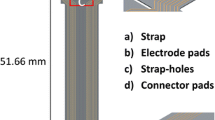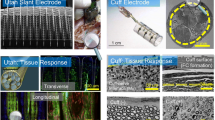Abstract
The goal of this study was to perform in situ electrochemical polymerization of poly(3,4-ethylenedioxythiophene) (PEDOT) in peripheral nerves to create a soft, precisely located injectable conductive polymer electrode for bi-directional communication. Intraneural PEDOT polymerization was performed to target both outer and inner fascicles via custom fabricated 3D printed cuff electrodes and monomer injection strategies using a combination electrode-cannula system. Electrochemistry, histology, and laser light sheet microscopy revealed the presence of PEDOT at specified locations inside of peripheral nerve. This work demonstrates the potential for using in situ PEDOT electrodeposition as an injectable electrode for recording and stimulation of peripheral nerves.




Similar content being viewed by others
References
W.M. Grill and J.T. Mortimer: Neural and connective tissue response to long-term implantation of multiple contact nerve cuff electrodes. J. Biomed. Mater. Res. 50, 215 (2000).
N. Lago, D. Ceballos, F.J. Rodríguez, T. Stieglitz, and X. Navarro: Long term assessment of axonal regeneration through polyimide regenerative electrodes to interface the peripheral nerve. Biomaterials 26, 2021 (2005).
N. Lago, K. Yoshida, K.P. Koch, and X. Navarro: Assessment of biocompatibility of chronically implanted polyimide and platinum intrafascicular electrodes. IEEE Trans. Biomed. Eng. 54, 281 (2007).
N. de la Oliva, X. Navarro, and J. del Valle: Time course study of long-term biocompatibility and foreign body reaction to intraneural polyimide-based implants. J. Biomed. Mater. Res.—Part A 106, 746 (2017).
M.R. Abidian and D.C. Martin: Multifunctional Nanobiomaterials for Neural Interfaces. Adv. Funct. Mater. 19, 573 (2009).
M. Asplund, T. Nyberg, and O. Inganäs: Electroactive polymers for neural interfaces. Polym. Chem. 1, 1374 (2010).
X. Cui and D.C. Martin: Electrochemical deposition and characterization of poly(3,4-ethylenedioxythiophene) on neural microelectrode arrays. Sensors Actuators B 89, 92 (2003).
R. Green and M.R. Abidian: Conducting polymers for neural prosthetic and neural interface applications. Adv. Mater. 27, 7620 (2015).
S.J. Wilks, S.M. Richardson-Burns, J.L. Hendricks, D.C. Martin, and K.J. Otto: Poly(3,4-ethylenedioxythiophene) as a micro-neural interface material for electrostimulation. Front. Neuroeng. 2, 1 (2009).
J. Yang, D.H. Kim, J.L. Hendricks, M. Leach, R. Northey, and D.C. Martin: Ordered surfactant-templated poly(3,4-ethylenedioxythiophene) (PEDOT) conducting polymer on microfabricated neural probes. Acta Biomater. 1, 125 (2005).
K.A. Ludwig, J.D. Uram, J. Yang, D.C. Martin, and D.R. Kipke: Chronic neural recordings using silicon microelectrode arrays electrochemically deposited with a poly (3,4-ethylenedioxythiophene) (PEDOT) film. J. Neural Eng 3, 59 (2006).
S.J. Wilks, A.J. Woolley, L. Ouyang, D.C. Martin, and K.J. Otto: In vivo Polymerization of Poly(3,4-ethylenedioxythiophene) (PEDOT) in Rodent Cerebral Cortex. Proceedings of the 33rd Annual IEEE EMBC International Conference, 2011.
X.T. Cui, and D.D. Zhou: Poly (3,4-Ethylenedioxythiophene) for chronic neural stimulation. IEEE Trans. Neural Syst. Rehabil. Eng. 15, 502 (2007).
T.D.Y. Kozai, K. Catt, Z. Du, K. Na, O. Srivannavit, R.M. Haque, J. Seymour, K.D. Wise, E. Yoon, and X.T. Cui: Chronic In vivo evaluation of PEDOT/CNT for stable neural recordings. IEEE Trans. Biomed. Eng. 63, 111 (2016).
K.A. Ludwig, N.B. Langhals, M.D. Joseph, S.M. Richardson-Burns, J.L. Hendricks, and D.R. Kipke: Poly(3,4-ethylenedioxythiophene) (PEDOT) polymer coatings facilitate smaller neural recording electrodes. J. Neural Eng 8, 1 (2011).
S. Venkatraman, J. Hendricks, Z.A. King, A.J. Sereno, S. Richardson-Burns, D. Martin, and J.M. Carmena: In vitro and In vivo evaluation of PEDOT microelectrodes for neural stimulation and recording. IEEE Trans. Neural Syst. Rehabil. Eng. 19, 307 (2011).
N.A. Alba, Z.J. Du, K.A. Catt, T.D.Y. Kozai, and X.T. Cui: In vivo electrochemical analysis of a PEDOT/MWCNT neural electrode coating. Biosensors 5, 618 (2015).
C. Boehler, C. Kleber, N. Martini, Y. Xie, I. Dryg, T. Stieglitz, U.G. Hofmann, and M. Asplund: Actively controlled release of Dexamethasone from neural microelectrodes in a chronic in vivo study. Biomaterials 129, 176 (2017).
J.A. Chikar, J.L. Hendricks, S.M. Richardson-Burns, Y. Raphael, B.E. Pfingst, and D.C. Martin: The use of a dual PEDOT and RGD-functionalized alginate hydrogel coating to provide sustained drug delivery and improved cochlear implant function. Biomaterials 33, 1982 (2012).
N. Bhagwat, K.L. Kiick, and D.C. Martin: Electrochemical deposition and characterization of carboxylic acid functionalized PEDOT copolymers. J. Mater Res 29, 2835 (2014).
K.E. Feldman, and D.C. Martin: Functional conducting polymers via Thiol-ene Chemistry. Biosensors 2, 305 (2012).
N.K. Guimard, N. Gomez, and C.E. Schmidt: Conducting polymers in biomedical engineering. Prog. Polym. Sci. 32, 876 (2007).
L. Ouyang, C. Shaw, C. Kuo, A. Griffin, and D. Martin: In vivo polymerization of poly (3 4-ethylenedioxythiophene) in the living rat hippocampus does not cause a significant loss of performance in a delayed alternation task. J. Neural Eng. 11, 1 (2014).
S.M. Richardson-Burns, J.L. Hendricks, B. Foster, L.K. Povlich, D.H. Kim, and D.C. Martin: Polymerization of the conducting polymer around living neural cells. Biomaterials 28, 1539 (2007a).
S.M. Richardson-Burns, J.L. Hendricks, and D.C. Martin: Electrochemical polymerization of conducting polymers in living neural tissue. J. Neural Eng 4, L6 (2007b).
B.M. Egeland, M.G. Urbanchek, A. Peramo, S.M. Richardson-Burns, D.C. Martin, D.R. Kipke, W.M. Kuzon, and P.S. Cederna: In vivo electrical conductivity across critical nerve gaps using Poly(3,4-ethylenedioxythiophene)-coated neural interfaces. Plast. Reconstr. Surg. 126, 1865 (2010).
M.G. Urbanchek, T.A. Kung, C.M. Frost, D.C. Martin, L.M. Larkin, A. Wollstein, and P.A. Cederna: Development of a regenerative peripheral nerve interface for control of a neuroprosthetic limb. Biomed Res. Int. 2016, 1 (2016).
Y. Tong, J.M. Murbach, V. Subramanian, S. Chhatre, F. Delgado, D.C. Martin, K.J. Otto, M. Romero-Ortega, and B.N. Johnson: A hybrid 3D printing and robotic-assisted embedding approach for design and fabrication of nerve cuffs with integrated locking mechanisms. MRS Adv (2018) doi. 10.1557/adv.2018.378.
K. Chung, J. Wallace, S.Y. Kim, S. Kalyanasundaram, A.S. Andalman, T.J. Davidson, J.J. Mirzabekov, K.A. Zalocusky, J. Mattis, A.K. Denisin, S. Pak, H. Berstein, C. Ramakrishnan, L. Grosenick, V. Gradinaru, and K. Deisseroth: Structural and molecular interrogation of intact biological systems. Nature 497, 332 (2013).
S.F. Cogan: Neural stimulation and recording electrodes. Annu. Rev. Biomed. Eng. 10, 275 (2008).
Acknowledgments
This work was sponsored by the Defense Advanced Research Projects Agency (DARPA) Biological Technologies Office (BTO) Targeted Neural Plasticity (TNT) program under the auspices of Drs. Doug Weber and Tristan McClure-Begley through the DARPA Contracts Management Office: No. HR0011-17-2-0019 and the National Science Foundation (NSF CMMI—1739318).
Author information
Authors and Affiliations
Corresponding author
Rights and permissions
About this article
Cite this article
Murbach, J.M., Currlin, S., Widener, A. et al. In situ electrochemical polymerization of poly(3,4-ethylenedioxythiophene) (PEDOT) for peripheral nerve interfaces. MRS Communications 8, 1043–1049 (2018). https://doi.org/10.1557/mrc.2018.138
Received:
Accepted:
Published:
Issue Date:
DOI: https://doi.org/10.1557/mrc.2018.138




